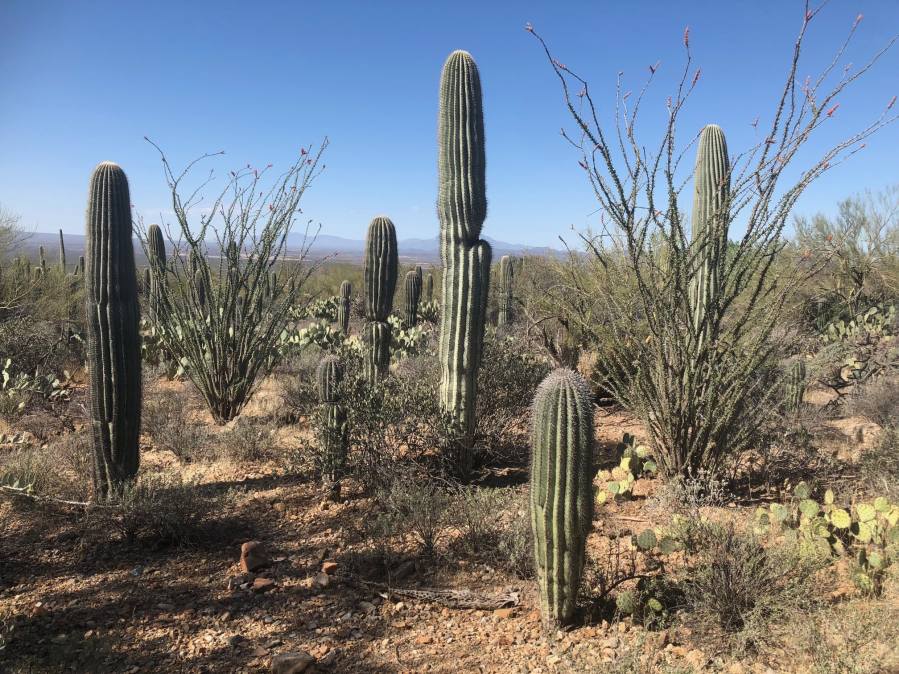James Clark goes for a walk among the cacti of the Sonoran Desert – and is rewarded by some wildlife sightings
By James Clark
The Sonoran Desert is one of the most biologically diverse deserts in the world. It holds the title of being the only maritime desert in North America, and it covers 100,000 square miles across Mexico and the US. The desert is lush due to two yearly rain seasons, with an average rainfall of 3-12 inches. Saguaro cacti stretch high up towards the sun.
To reach Saguaro National Park (west) from Tucson I took the Speedway Boulevard West to Gates Pass Road and turned right on to Kinney Road. I stopped at the Red Hills Visitor Center to get a map and use the facilities, and continued driving for a further five miles around the Bajada Scenic Loop, taking in the views around Hohokam Road and part of the Golden Gate Road. It’s such a beautiful and dramatic drive that while looking at the vast space of the mountainous desert I almost forgot my reason for coming here in the first place, which was to hike in an environment that I had not hiked before.
I found my first Tucson hiking adventure along the Sendero Esperanza and Kings Canyon Trails. The trails wind through dense saguaro and other plants of the Sonoran, and connect to several smaller trails, enabling me to jump from one trail to another.
The hike was hot, but I found groups of friendly and happy people walking every couple of hundred metres or so. The local community uses these paths as much as visitors. There’d be little point living in Tucson if you weren’t an active hiker and / or mountain biker. This is where fit people live.
I chose to push past the seven-mile round-trip loop and extend another four miles to the highest point in the park, Wasson Peak, 4,687ft above sea level. At the top I found a small area of shade and enjoyed the 360˚ views of the region. The clouds coming over Wasson Peak gave the desert a dramatic look. Capturing an iconic shot of the lone saguaro cactus didn’t come without challenges due to the denseness of flora and mountains, but the opportunity to capture desert shadows made up for it.
If Donald Trump builds the wall that he keeps talking about then some of these animals will lose part of their native habitat
Boundless wildlife lives in the Sonoran Desert, but I didn’t see much of it. Wildlife can be elusive, and black bears and other animals have a habit of being difficult to spot during the daytime, when they tend to hide from humans and seek shade from the heat. To see desert wildlife, I took a short drive to the Arizona-Sonora Desert Museum.
I’m not a fan of museums, but this place really is one by name only. It covers 100 acres and is a safe environment to get to know the Sonoran Desert by removing both the fear and chances of getting lost.
Within the Arizona-Sonora Desert Museum is the desert loop hiking trail. The trail is hot, dry, dusty, bumpy and uphill on the way back, but on the inclined path I realised that I’d made the right decision as I passed a coyote and a javelina skunk pig.



At the end of the trail the desert grassland area is home to two mountain wolves (there are only 50 remaining in the wild), black bear, white-tailed deer and a mountain lion, and a zoo with rescued prairie dogs, desert tortoise, vultures, great blue heron and various reptiles, invertebrates and amphibians. I’m very much an anti-zoo kind of person, but these were all being reared back to good health to be released back into the wild.
There is a real concern for wildlife in Tucson. The border with Mexico is only an hour’s drive from the city, and many species of animals wander backwards and forwards between the two countries. If Donald Trump builds the wall that he keeps talking about then some of these animals will lose part of their native habitat, and the mountain wolves and other species face extinction.
In the morning I headed to the Sabino Canyon, located in Tucson’s Coronado National Forest. I took the Bear Canyon tram to the end of the line, and hiked back from there (7.8 mile), as I’d been told that it offered the best views and abundant. It’s a beautiful hike into the canyon, which would have been rewarded with waterfalls – it’s possible to find water in the desert – and several streams to be crossed on foot. At various times of the year the water can get deep, but not when I visited in March. There wasn’t a drop of water in sight.
Precautions
- Off-trail hiking below 4,500ft isn’t recommended. Hiking in the extreme heat can be hazardous so take it easy and be prepared; you won’t find water on the trails except in the Arizona-Sonora Desert Museum.
- In 2017 a local woman went hiking on Mount Lemmon. She fell, broke her ankle and spent a week dragging herself through the desert and forests, eating grass before she was found. She is one of the lucky ones.
- Watch out for cacti and venomous snakes.
- The best time to visit is between October and April when temperatures reach the upper 60s to mid 80s (roughly 20˚C-30˚C) during the day. From May to September it gets so hot that the locals get up and head out early to be home and indoors by 8am. Highs routinely exceed 110˚F (43˚C).
All images © James Clark








